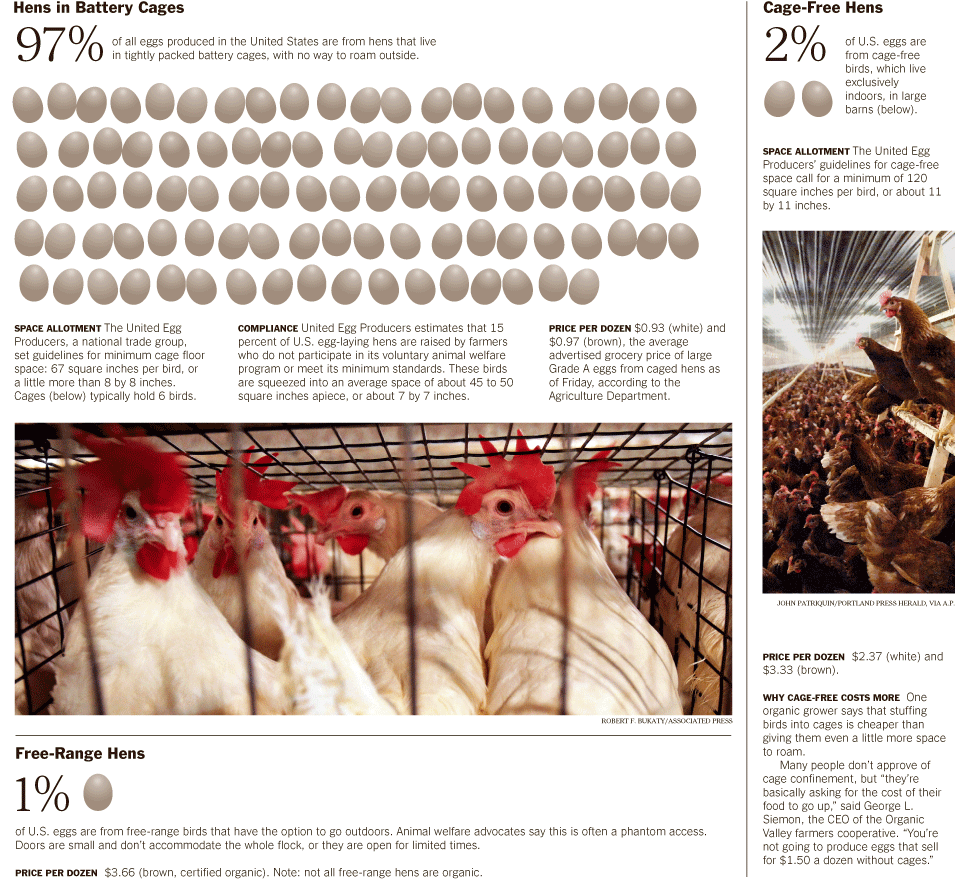
Last Sunday’s New York Times Week in Review section took a look at burgeoning cage-free regulations for egg-laying hens in California, Oregon, Arizona, Colorado, Michigan, Ohio, Florida and Maine. Currently only 2% of America’s hens are raised outside of battery cages (8 x 8 inches allotted to each bird; 6 birds to a cage).
After Iowa, Ohio is America’s second largest producer of eggs and the Buckeye state is the latest to adopt new anti-confinement standards. Animal welfare groups and farmers have agreed to phase out small crates for gestating hogs and veal calves, and to ban new cages for egg-laying hens (existing cages can remain) in Ohio.
The average price of a dozen organic, cage-free eggs is about $3.66 while conventional eggs run $0.93. So, attention Whole Foods shoppers… A family of four living in the second Great Depression, their passion for animal welfare notwithstanding, is unlikely to regularly pay four times for this staple.
Animal welfare groups such as the Humane Society of the United States have aggressively pushed the $590 billion US food-service industry to adopt and promote cage-free egg purveyors. Bon Appetit Management adopted a commitment to purchase only cage-free SHELL eggs. While Bon Appetit has made a strong marketing move with its cage-free policy, the conceit of this decision is that SHELL eggs only account for about 2% of the eggs served in a commercial food service operation — the same proportion as the share of eggs raised cage-free in the US.
There’s no doubt that combination of increased consumer awareness and the dogged work of NGOs like the Humane Society has produced increased public policy in the cage-free egg arena. What is less clear is how impactful these highly-publicized debates have been against an overall objective of increasing animal welfare.
Finally, and forgive the maudlin tone of this post, the cost to produce cage-free eggs is higher potentially pushing smaller producers out of the market. But critics of CSR and sustainability often lament that the lack of high impact priorities creates tepid, green-washed programs. And we need to balance the materiality of CSR execution strategy with consumer demand.
So, the question lingers, should cage-free eggs be a significant component of large-scale sustainable agricultural policy in commerical food service or state legislatures?






Thanks for the interesting post.
California and Michigan (two large egg production states) have banned and are phasing out cage confinement of laying hens. Major food companies (like Hellmann’s mayo — which uses 350 million eggs/yr) have announced they’re going 100$ cage-free. Compass Group (the largest food service provider in the world) has already converted 100 million eggs it uses in its US operations to cage-free and intends to do even more.
According to the egg industry’s trade group, five percent (not two percent) of all eggs produced in the US are cage-free. That number will continue to increase as more states and socially responsible retailers demand reform from the egg industry.
Thanks for the interesting post.
California and Michigan (two large egg production states) have banned and are phasing out cage confinement of laying hens. Major food companies (like Hellmann’s mayo — which uses 350 million eggs/yr) have announced they’re going 100$ cage-free. Compass Group (the largest food service provider in the world) has already converted 100 million eggs it uses in its US operations to cage-free and intends to do even more.
According to the egg industry’s trade group, five percent (not two percent) of all eggs produced in the US are cage-free. That number will continue to increase as more states and socially responsible retailers demand reform from the egg industry.
Salmonella anyone? A very apt post, should repost in light of the current egg recall.
agreed
My family purchased our first dozen cage free brown eggs laswt weekend at Wal-Mart at the Steelyard Commons store. They were $2 and tasted delicious! I suppose it is because the chickens were happy and destressed at not being “cooped up!” Cage free eggs for us!
I personally CHOOSE to purchase cage-free eggs because I feel there is a better taste to them along with better nutrition along with the fact that I appreciate the more humane treatment of the birds. Having said that, I have grave concerns about legislation FORCING farmers to go cage-free and driving up the cost of egg production for everyone. There are already enough working families struggling to make ends meet without incurring the increased costs of food production due to more government regulation that will inevitably be passed on to them.
According to Wikipedia,
Based on data in the European Commission’s socio-economic report, it costs €0.66 to produce 12 battery eggs, €0.82 to produce 12 barn eggs and €0.98 to produce 12 free-range eggs.
So 12 free-range eggs cost €0.32 more to produce than 12 battery eggs, and 12 barn eggs cost €0.16 more to produce than 12 battery eggs.
This means that one free-range egg costs 2.6 Eurocents (3.4-US-cents) more to produce than a battery egg, In other words, it costs 42-US-cents more to produce a dozen free range eggs, that those raised in battery cages
and a barn egg costs 1.3 Euro cents (1.7-UScents) more to produce than a battery egg, or 20 US-cents more per dozen
The Commission’s report concludes that, if costs were to increase by 20%, which it says is the type of percentage increase in terms of variable costs that producers are likely to face as a result of switching to free-range, the industry will potentially suffer a loss of producer surplus of €354 million (EU-25). If, however, this increased cost were borne not by farmers but by consumers paying a little extra for eggs, each EU citizen would only have to pay less than €1 extra per year, as the human population of the EU-25 is around 460 million.
The main point is, that battery cages represents the ugliest side of human behavior, and a very cruel method of torture for these animals, who are already destined to die well before their time. I am certain the vast majority of Americans would gladly pay a few extra dollars more, to allow these hens to spead their wings, and not have to live with dead hens in their cages, and birds defacting from above onto their bodies, and having their beaks buned off. We are not a cruel society, and Americans must demand that the egg farmers let the hens out of their cages. –